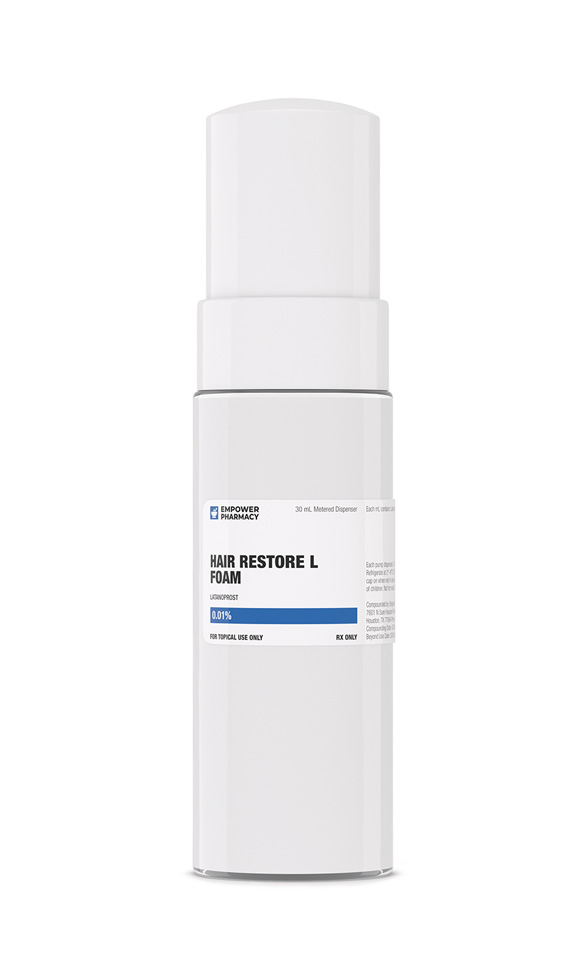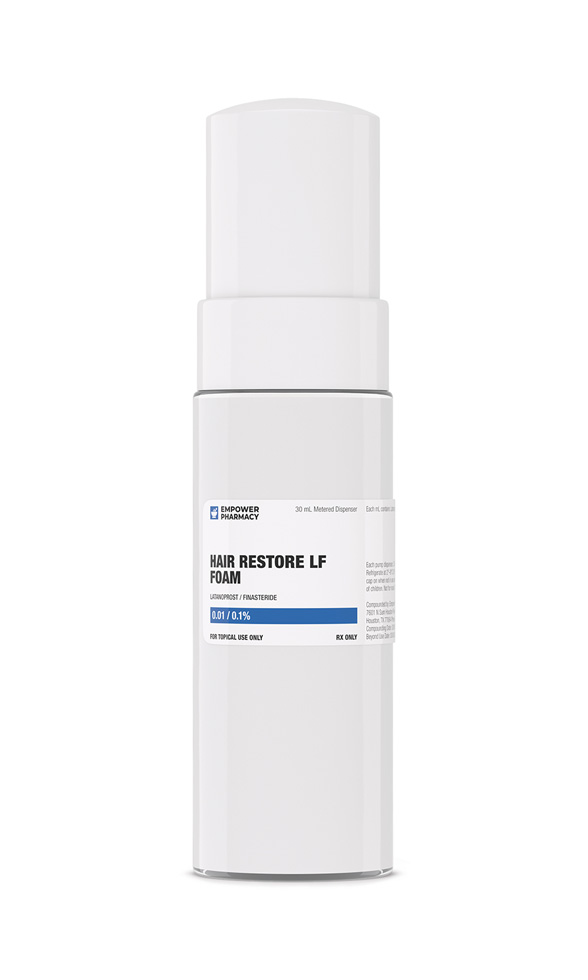- Description
- Reviews (0)
- Store Policies
- Inquiries
Description
Overview of Hair Restore L Foam
-
Dosage Strength of Hair Restore L Foam
- Latanoprost 0.01% 30 mL Foam Pump
Latanoprost 0.06% 30 mL Foam Pump
Latanoprost 0.1% 30 mL Foam Pump
Latanoprost, an analog of prostaglandin F2alpha, is a prodrug used to reduce elevated intraocular pressure (IOP) in patients with open-angle glaucoma or ocular hypertension. Studies have shown that latanoprost administered once daily is at least as effective as timolol in lowering intraocular pressure. When latanoprost and timolol were used in combination, a complete or almost complete additive effect in reducing intraocular pressure has been observed. Treatment has been associated with increased pigmentation of the iris, periorbital tissue (eyelid) and eyelashes.
Latanoprost is a selective agonist at a subtype of prostaglandin receptors known as the FP receptor. By acting on the FP receptor, latanoprost increases the outflow of aqueous humor thereby reducing intraocular pressure. According to the manufacturer, studies in both animals and man suggest that increased uveoscleral outflow is the primary mechanism of action.
Latanoprost should not be used in patients with closed-angle glaucoma, or inflammatory or neovascular glaucoma. There is limited experience with latanoprost in these patients.
Latanoprost should be used with caution in patients with aphakia, pseudophakic patients with a torn posterior lens capsule, and patients with known risk factors for macular edema. Macular edema, including cystoid macular edema, has been reported during treatment with this drug.
Recipients of latanoprost may experience a gradual increase in pigmentation (i.e., brown coloration) of the iris and periorbital tissue (eyelids), which may not be noticeable for several months to years. Patients who develop increased pigmentation may continue to receive treatment; however, these patients should be examined regularly as they may develop photophobia or be more sensitive to sunlight (UV) exposure. After discontinuing latanoprost, the change in iris color is likely to be permanent, while the pigmentation change in the periorbital tissue may be reversible in some patients. Eyelash changes (i.e., increased length, thickness, pigmentation, the number of lashes or hairs, and misdirected growth of eyelashes) has also been associated with the use of latanoprost. Eyelash changes are usually reversible upon treatment discontinuation. Inform drug recipients of the possibility of iridal and eyelid discoloration, and of the potential for eyelash changes.
Latanoprost should be used with caution in patients with active intraocular inflammation (e.g., iritis, uveitis). Use of latanoprost in these patient may exacerbate inflammation.
Instruct drug recipients to remove contact lenses before instilling latanoprost ophthalmic drops. Lenses may be reinserted 15 minutes after drug administration. The ophthalmic solution is formulated with the preservative benzalkonium chloride, which may be absorbed by soft contact lenses.
The use of multiple dose containers of ophthalmic products has been associated with bacterial keratitis. Inadvertent contamination of the latanoprost containers may increase the risk of infection in ocular surgery patients, or in patients who develop an ocular infection or ocular trauma, including corneal abrasion. If there is any damage to the ocular epithelial surface, latanoprost should be used with caution. Reactivation of herpes simplex keratitis has been reported during latanoprost therapy. Use caution in patients with a history of herpetic keratitis; avoid use in patients with active herpes simplex keratitis due to the potential for exacerbation of inflammation.
Latanoprost is classified as FDA pregnancy risk category C. Although there are no adequate and well-controlled studies in pregnant women, limited experience in human pregnancy has not resulted in clinically significant risk to the fetus. A minimal amount of drug reaches systemic circulation after ophthalmic administration, suggesting exposure of the drug to the fetus is low. According to the manufacturer, latanoprost should be used during pregnancy only if the potential benefit justifies the potential risk to the fetus.3
According to the manufacturer, it is not known whether latanoprost or its metabolites are excreted in breast milk. Because systemic plasma concentrations of latanoprost are low and the half-life is short after ophthalmic administration, clinically significant amounts of the drug would not be expected to be excreted in breastmilk. To further minimize the amount of drug that reaches the systemic circulation and breast milk, apply pressure over the tear duct by the corner of the eye for 1 minute after ophthalmic administration. According to the manufacturer, caution should be exercised when latanoprost is administered during breast-feeding. Consider the benefits of breast-feeding, the risk of potential infant drug exposure, and the risk of an untreated or inadequately treated condition. If a breastfeeding infant experiences an adverse effect related to a maternally ingested drug, healthcare providers are encouraged to report the adverse effect to the FDA.
Safety and efficacy of latanoprost have not been established in the pediatric population (i.e., neonates, infants, children, or adolescents).
Latanoprost should be used cautiously in patients with renal disease (e.g., renal failure, renal impairment) or hepatic disease. There have been no studies on safe use in these patients.
Latanoprost is classified as FDA pregnancy risk category C. Although there are no adequate and well-controlled studies in pregnant women, limited experience in human pregnancy has not resulted in clinically significant risk to the fetus. A minimal amount of drug reaches systemic circulation after ophthalmic administration, suggesting exposure of the drug to the fetus is low. According to the manufacturer, latanoprost should be used during pregnancy only if the potential benefit justifies the potential risk to the fetus.
According to the manufacturer, it is not known whether latanoprost or its metabolites are excreted in breast milk. Because systemic plasma concentrations of latanoprost are low and the half-life is short after ophthalmic administration, clinically significant amounts of the drug would not be expected to be excreted in breastmilk. To further minimize the amount of drug that reaches the systemic circulation and breast milk, apply pressure over the tear duct by the corner of the eye for 1 minute after ophthalmic administration. According to the manufacturer, caution should be exercised when latanoprost is administered during breastfeeding. Consider the benefits of breastfeeding, the risk of potential infant drug exposure, and the risk of an untreated or inadequately treated condition. If a breastfeeding infant experiences an adverse effect related to a maternally ingested drug, healthcare providers are encouraged to report the adverse effect to the FDA.
Asthma or asthma exacerbations (bronchospasm) and dyspnea have been reported during postmarketing experience with latanoprost.
Infection (i.e., upper respiratory tract infection, naso-pharyngitis, influenza) was reported in 3% of patients receiving latanoprost during clinical trials. Cases of herpes keratitis have been reported with postmarketing use.
Postmarketing use of latanoprost has been associated with cases of palpitations, unstable angina, and chest pain (unspecified).
Myalgia, arthralgia, musculoskeletal pain, and back pain were reported in 1% of patients during latanoprost clinical trials.
Rash and other allergic skin reactions were reported at a rate of 1% during latanoprost clinical trials. Cases of pruritus and toxic epidermal necrolysis have been reported during postmarketing use of latanoprost.
Dizziness and headache have been reported during postmarketing experience with latanoprost.3
Store this medication at 68°F to 77°F (20°C to 25°C) and away from heat, moisture and light. Keep all medicine out of the reach of children. Throw away any unused medicine after the beyond use date. Do not flush unused medications or pour down a sink or drain.
1.Fristrom B. A 6-month, randomized, double-masked comparison of latanoprost with timolol in patients with open angle glaucoma or ocular hypertension. Acta Ophthalmol Scand 1996;74:140-4.
2.Mishima HK, et al. A comparison of latanoprost and timolol in primary open-angle glaucoma and ocular hypertension. Arch Ophthal 1996;114:929-32.
3.Xalatan (latanoprost ophthalmic solution) package insert. New York, NY: Pfizer; 2017 Apr.
4.Xelpros (latanoprost) ophthalmic emulsion 0.005% package insert. Cranbury, NJ: Sun Pharmaceutical Industries, Inc.; 2018 Sept.
5.Briggs, Freeman, Yaffee. Latanoprost. Update, Drugs in Pregnancy and Lactation. 2011:24;5-6.
Be the first to review “Hair Restore L Foam”
General Inquiries
There are no inquiries yet.










Reviews
There are no reviews yet.